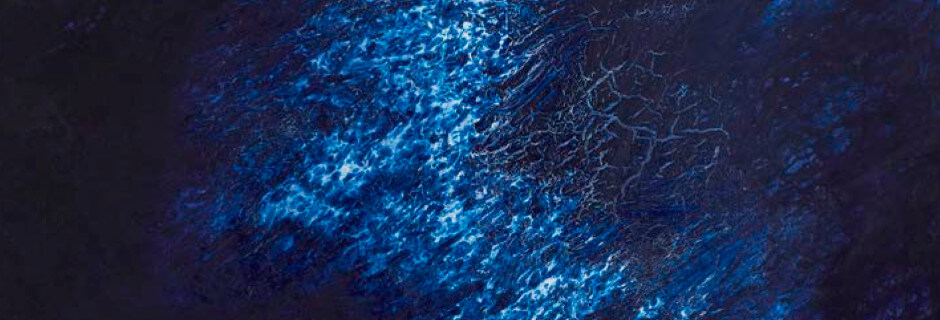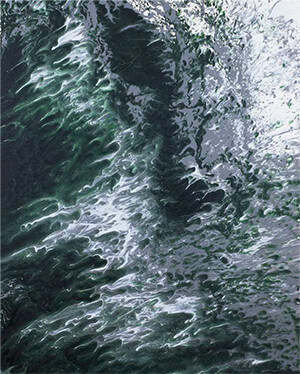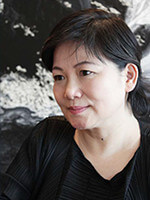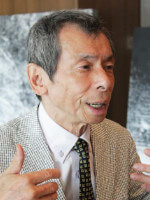Special Interview Lou Zhenggang and Nobuyuki Senzoku (The director of Hiroshima Prefectural Museum of Art)
An artist’s journey toward truth
UPDATE 2020.1.20

《untiled》 キャンバス、油彩 60S 2018年
Lou Zhenggang, the Chinese calligrapher, painter and also acknowledged child prodigy, is once again attracting attention from the world of art. The exquisite calligrapher's talent has been evident since her childhood, when she was certified as an “exceptionally gifted prodigy” for enrollment in a special program in Beijing. Thirty years ago at the age of 20, she moved to Japan and begun her international journey of calligraphy and painting in Tokyo, New York and Beijing. This coming October, “Ever-Evolving Worldwide Asian Artists Right Now 3!” will take place at the Karuizawa New Art Museum. This exhibition introduces the latest works of Lou Zhenggang and other internationally acclaimed contemporary artists such as Toshimitsu Imai, Yayoi Kusama and Hisao Domoto. Art critic, Nobuyuki Senzoku, sat down with the artist to catch a glimpse of her journey to the present.
The childhood of a “prodigy”
- Senzoku
- Ms. Lou, you are from Heilongjiang Province in China. When did you come to Japan?
- Lou
- In 1986, when I was twenty. I’ve been here now for thirty-three years, though I spent a few years living in New York along the way.
- Senzoku
- I heard many Chinese move abroad. Why did you choose Japan?

《untiled》 キャンバス、油彩 100F 2018年
- Lou
- There is a very well-known art supply store called Rong Bao Zhai, which was established more than three hundred years ago. During my teens, I was giving a calligraphy demonstration there and was praised by someone from a Japanese calligraphy group. After that, time passed and I continued learning my art; but I think the impression that the experience left with me influenced my decision. I felt that the first foreign country I should visit should be somewhere my talent was acknowledged.
- Senzoku
- The first person to realize your talent in painting and calligraphy was your calligrapher father, wasn’t it?
- Lou
- That's right. In China, there is a custom of putting chunlian, or spring festival couplets on the entrance to your home. Chunlian couplets are words that express good fortune. They are written on a slip of red paper, and one I wrote was quite young caught my father’s eye. He was a very strict teacher. He was working in PR for the coal mining industry. He would bring old newspapers home and make me practice with them until late at night. When I was twelve, my bloc-style calligraphy was noticed at an exhibition hosted by Heilongjiang Province. My father and I also had traveled to visit famous calligraphers all over China and asked them to teach me. When I was a kid, he often made me do calligraphy in front of people...
- Senzoku
- Could you tell me about the national education project after the Cultural Revolution? I heard that was a very special program only for gifted children with exceptional talent.
- Lou
- Those children were called “exceptionally gifted prodigies.” Because I was good at calligraphy and had a very good memory, I was granted special permission to enroll in the Central Academy of Fine Arts. It was when the Cultural Revolution was winding down and there weren't many children studying hard. I wouldn't be called a “child prodigy,” though, in the present world where everybody studies hard.
- Senzoku
- But you were already very famous.
- Lou
- At that time I practiced by writing on the street with water. No one in the history of Chinese calligraphy history had ever done this before, so lots of media came for interviews. This was even included in textbooks. However, having been involved in politics and power conflicts of the people who were supporting me, my life took a turn for the worse.
- Senzoku
- You certainly are a survivor having gone through a turbulent time in Chinese history. By the way, when did you start thinking about a career as an artist?
- Lou
- I can't really say when exactly. I have continued my calligraphy and painting since I was little, and this is just something I will always do throughout my life no matter how others judge my works.
- Senzoku
- Many artists are influenced by other artist in their youth. What about you?
- Lou
- My hometown is a very cold mining village of the northernmost area of China. Not even a proper art book existed around that time. I worked in a very small room in a very small house. I looked out the window at a fruit tree, which happens to be my only memory of colors. The rest was just black dirt, coal and snow. So, I suppose that everything I saw became my textbooks as I grew.
Lou visited Japan in 1986 when she was twenty years old, and the following year she held her first solo exhibition in Japan. In 1998, she established the “Lou Zhenggang Art Education Development Fund,” which is devoted to the development of art in China. Once buffeted by the politics that caused trouble between China and Japan, she began to explore her true self as an artist when she embarked on an artistic journey through the worlds of Tokyo, New York and Beijing, vibrant worlds of explosive development and change.
Work at her art studio in Izu
- Senzoku
- You’re painting in Izu. Your seaside studio must be nice.
- Lou
- You're right. After all the hard experiences, just watching the vast blue sea encourages me.
- Senzoku
- Although you don’t draw landscapes specifically, I suppose you are greatly influenced by the rich nature that surrounds you. What is your actual process of creation? For example, some artists seem to work on a schedule to create just like office workers.
- Lou
- I work in the middle of the night. I used to love watching TV from 9 to 10 in the evening, and then painting until the next morning. Now I don't really have any hobbies or fun, and I'm not much motivated to meet people. I just shut myself in my studio and spend most of the time in front of the canvas except for when I’m sleeping and eating. I haven’t taken a break since last year.
- Senzoku
- That really is a tremendous effort. Are you working for any specific exhibitions?
- Lou
- I'm having an exhibition in October at an art museum in Karuizawa, but that isn’t the reason I've been creating. As I’m now over fifty, the way I think has changed. I believe that I should just keep painting. I still have the physical strength to create large pieces, and I no longer have second thoughts about what my art should focus on. My thinking recently is that I simply want to spend the rest of my time for creating.

《untiled》 キャンバス、油彩 145.5×436.5cm(80S×3) 2018年
- Senzoku
- What made you feel this way?
- Lou
- Why do I exist in this world? The answer is unknowable, but it might eventually show its shape as I keep painting. That could be the reason for my art.
- Senzoku
- You don't have any desire for recognition from others, or ambition to be rich?
- Lou
- No. I already had enough of that when I was young. I've created my own art for fifty years, and finding the reason for my existence in the universe is much more important to me now. Here I am, alive and able to paint. I have nothing else to wish for, and I thank God for this.
The endless quest of the Heart
- Senzoku
- Ms. Lou, you are a calligrapher and painter. How do you differentiate between painting and calligraphy?
- Lou
- For me, calligraphy is more challenging. Painting is a way of expressing my feelings at a time while calligraphy requires a devotion of my entire being.
- Senzoku
- Do you mean such revelations change the way you paint? To put it the other way around, can you recall the feeling you had at the time by looking at your past works?
- Lou
- Yes, I can. Along with some turning points in my life, I have definitely experienced major shifts in my painting style.
- Senzoku
- Your recent abstract acrylic paintings remind me of a nebula in the space or the Genesis-like chaotic energy of the universe. I believe creating such powerful work requires both physical and mental strength.
- Lou
- I appreciate your words. I recognize the painting large pieces is one of my strong points, so I'm very happy to hear such compliment.
- Senzoku
- In Chinese calligraphy and paintings the words “five colors of ink” * are often used, are you also conscious of colors in your monotone paintings?
- Lou
- Yes, I am. I’m aware of colors, of course, and I'm also aware of “flying white ” ** which has always been a natural part of me.
- Senzoku
- When you are creating an abstract painting, do you already have a blueprint in your mind before you begin, or does the piece gradually change during the painting process?
- Lou
- When I look into a blank piece of paper or canvas, the image what I should paint comes up in my heart. Nevertheless, both elements by necessity and accident act on my works; therefore, I can never paint the exact same thing; but then again, I don't want to paint the same thing twice.
- Senzoku
- People say things like “the style is the person” or “the writing is the person,” meaning the work reflects the creator's true self. Today I met with you and found that your works show the truth of Lou Zhenggang. This interview tells the story of your childhood as a “prodigy” and follows you to the present, but this doesn’t reveal everything. I'm looking forward to seeing your next project. Thank you very much for spending time with me today.
- Lou
- Thank you very much. I have kept painting for fifty years, but it's not enough. I'll keep painting even more. I hope you'll see what I do in the future.
■* In Chinese painting, ink can be thick or light, the ancients classified ink into five grades: charred, concentrated, heavy, light, and clear. These are the so-called “five colors of ink.”
■** A brush stroke technique of calligraphy represented by white parts to creates elegant curves and lines.

Lou Zhenggang
Born in 1966, Heilongjiang Province China. In 1977, Chinese Government recognized her as an “exceptionally gifted prodigy” and granted her special permission to enroll in the Central Academy of Fine Arts. In 1986, she visited Japan after leaving Beijing University. In 1987, she had her first solo exhibition in Japan (Tokyo Yaesu Gallery). In 1993, she traveled to the U.S. and donated the copyright of 22 of her works to UNICEF. In 1996, she held an exhibition featuring her latest works at New York. In 1998, she established the Lou Zhenggang Art Education Development Fund with Chinese Government. In 1999, she opened the Zhenggang Experimental Fine Art Academy from the same foundation. In 2007, 34 of her paintings became the first contemporary art collection owned by the National Museum of China. She also held a solo exhibition at the Ueno Royal Museum, Tokyo. In 2012, she held a solo exhibition at Today Art Museum in Beijing. In 2016, the “Lou Zhenggang Exhibition” was held by invitation of the Sultanate of Oman at Royal Opera House Muscat.

Nobuyuki Senzoku
Born in 1940. In 1964, he started his career at the National Museum of Western Art in Tokyo after graduating from the Faculty of Letters, the University of Tokyo. In 1970, he studied abroad at Ludwig-Maximilians-University, Munich. After returning to Japan, he worked as chief researcher at the National Museum of Western Art in Tokyo and as a professor of the faculty of Arts and Literature, Seijo University. He also directed various exhibitions. He is currently professor emeritus of Seijo University and the director of Hiroshima Prefectural Art Museum.


